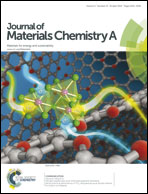Cellulose fibres with carbon nanotube networks for water sensing†
Abstract
Electroconductive cellulose-based fibres were fabricated by depositing multi-walled carbon nanotubes (MWNTs) on the surface using a simple and scalable dip coating. The morphology, mechanical properties and conductive properties of the resultant MWNT–cellulose fibres were investigated by scanning electron microscopy, tensile testing and electrical resistance measurement, respectively. The resistance (RL) of the single MWNT–cellulose fibre can be controlled in a wide range of 50–200 000 kΩ cm−1 by varying the conditions of dip coating. The sensing behaviour of these fibres to liquid water was investigated in detail. The results showed that they exhibit rapid response, high sensitivity and good reproducibility to water, with a relative electrical resistance change of about 100–8000% depending on the initial resistance. It was proposed that the disconnection of MWNT networks caused by swelling effects of the cellulose fibres is the dominant mechanism. Moreover, the sensitivity of the MWNT–cellulose fibres to an electrolyte solution was also investigated.


 Please wait while we load your content...
Please wait while we load your content...